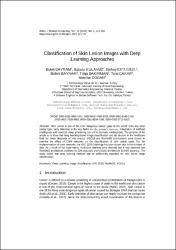Please use this identifier to cite or link to this item:
https://hdl.handle.net/20.500.11779/1804Full metadata record
| DC Field | Value | Language |
|---|---|---|
| dc.contributor.author | Kulavuz, Bahadır | - |
| dc.contributor.author | Ertuğrul, Berkay | - |
| dc.contributor.author | Bakırman, Tolga | - |
| dc.contributor.author | Çakar, Tuna | - |
| dc.contributor.author | Doğan, Metehan | - |
| dc.contributor.author | Bayram, Bülent | - |
| dc.contributor.author | Bayram, Buket | - |
| dc.date.accessioned | 2022-07-19T12:31:56Z | - |
| dc.date.available | 2022-07-19T12:31:56Z | - |
| dc.date.issued | 2022 | - |
| dc.identifier.citation | Bayram, B., Kulavuz, B., Ertugrul, B., Bayram, B., Bakirman, T., Cakar, T., & Doğan, M. (2022). Classification of Skin Lesion Images with Deep Learning Approaches. Baltic Journal of Modern Computing, 10(2), pp. 241-250. https://doi.org/10.22364/bjmc.2022.10.2.10 | en_US |
| dc.identifier.issn | 2255-8950 | - |
| dc.identifier.issn | 2255-8942 | - |
| dc.identifier.uri | https://hdl.handle.net/20.500.11779/1804 | - |
| dc.identifier.uri | https://doi.org/10.22364/bjmc.2022.10.2.10 | - |
| dc.description.abstract | Skin cancer is one of the most dangerous cancer types in the world. Like any other cancer type, early detection is the key factor for the patient's recovery. Integration of artificial intelligence with medical image processing can aid to decrease misdiagnosis. The purpose of the article is to show that deep learning-based image classification can aid doctors in the healthcare field for better diagnosis of skin lesions. VGG16 and ResNet50 architectures were chosen to examine the effect of CNN networks on the classification of skin cancer types. For the implementation of these networks, the ISIC 2019 Challenge has been chosen due to the richness of data. As a result of the experiments, confusion matrices were obtained and it was observed that ResNet50 architecture achieved 91.23% accuracy and VGG16 architecture 83.89% accuracy. The study shows that deep learning methods can be sufficiently exploited for skin lesion image classification. © 2022 Baltic Journal of Modern Computing. All rights reserved. | en_US |
| dc.language.iso | en | en_US |
| dc.publisher | University of Latvia | en_US |
| dc.rights | info:eu-repo/semantics/openAccess | en_US |
| dc.subject | Deep learning | en_US |
| dc.subject | Isic 2019 | en_US |
| dc.subject | Resnet50 | en_US |
| dc.subject | Image classification | en_US |
| dc.subject | Vgg16 | en_US |
| dc.title | Classification of Skin Lesion Images With Deep Learning Approaches | en_US |
| dc.type | Article | en_US |
| dc.identifier.doi | 10.22364/bjmc.2022.10.2.10 | - |
| dc.identifier.scopus | 2-s2.0-85133124398 | en_US |
| dc.authorid | Tuna Çakar / 0000000185947399 | - |
| dc.description.woscitationindex | Emerging Sources Citation Index | - |
| dc.description.WoSDocumentType | Article; Proceedings Paper | |
| dc.description.WoSInternationalCollaboration | Uluslararası işbirliği ile yapılmayan - HAYIR | en_US |
| dc.description.WoSPublishedMonth | July | en_US |
| dc.description.WoSIndexDate | 2022 | en_US |
| dc.description.WoSYOKperiod | YÖK - 2021-22 | en_US |
| dc.identifier.scopusquality | Q3 | - |
| dc.relation.publicationcategory | Makale - Uluslararası Hakemli Dergi - Kurum Öğretim Elemanı | en_US |
| dc.identifier.endpage | 250 | en_US |
| dc.identifier.startpage | 241 | en_US |
| dc.identifier.issue | 2 | en_US |
| dc.identifier.volume | 10 | en_US |
| dc.department | Mühendislik Fakültesi, Bilgisayar Mühendisliği Bölümü | en_US |
| dc.relation.journal | Baltic Journal of Modern Computing | en_US |
| dc.identifier.wos | WOS:000821052300011 | en_US |
| dc.institutionauthor | Çakar, Tuna | - |
| item.grantfulltext | open | - |
| item.fulltext | With Fulltext | - |
| item.languageiso639-1 | en | - |
| item.openairetype | Article | - |
| item.openairecristype | http://purl.org/coar/resource_type/c_18cf | - |
| item.cerifentitytype | Publications | - |
| crisitem.author.dept | 02.02. Department of Computer Engineering | - |
| Appears in Collections: | Bilgisayar Mühendisliği Bölümü Koleksiyonu Scopus İndeksli Yayınlar Koleksiyonu / Scopus Indexed Publications Collection WoS İndeksli Yayınlar Koleksiyonu / WoS Indexed Publications Collection | |
Files in This Item:
| File | Description | Size | Format | |
|---|---|---|---|---|
| 10_2_10_Bayram.pdf | Full Text - Article | 676.46 kB | Adobe PDF |  View/Open |
CORE Recommender
SCOPUSTM
Citations
2
checked on Nov 16, 2024
Page view(s)
30
checked on Nov 18, 2024
Download(s)
32
checked on Nov 18, 2024
Google ScholarTM
Check
Altmetric
Items in GCRIS Repository are protected by copyright, with all rights reserved, unless otherwise indicated.